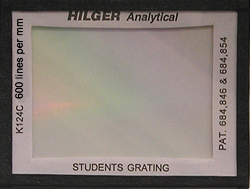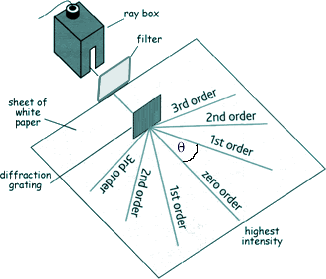To determine the wavelengths of the components of white light using a diffraction grating Introduction White light is a mixture of light of a range of colours with wavlengths from 400 nm to 760 nm. A single colour of light can be obtained by using a filter to remove light of other wavelengths from the mixture. When a monochromatic beam of light is passed thorugh a diffraction grating the light splits into diffracted beams. The angle of diffraction θ for the nth order of diffraction from the centre depends on the wavelength λ of the light in accordance with the equation d sin θ = nλThe bigger the wavelength the greater the diffraction - so red light diffracts more than blue.
The higher the order of diffraction the fainter the diffracted rays as a smaller percentage of the light is refracted at a higher order. The equation and measurements of the angle of diffraction θ can be used to calculate the wavelength of the diffracted light. Safety Not many safety issues with this experiment - just switch off the ray box when you are not using it or if it becomes too hot. Apparatus
Procedure Direct a narrow beam of light normally at the centre of the grating. Insert a colour filter and measure angle θ from the zero order beam to the diffracted ray - first for the right hand diffracted ray and then for the left hand diffraction. This will check that yur measurement is correct. Do this for each order visible. Record your results in a table. Analysis of Results d sin θ = nλ so. λ =d sin θ/n Calculate the grating spacing 'd'. 'd' is the reciprocal of the number of lines per metre of the grating you are using. Remember that the grating will have the number of lines per millimetre written on it... you have to conver the number to the number per metre before you can use it. Calculate the average of the measurement of θ for each order of diffraction visible Look up the sine of the angle and insert the value into the equation. You can then calculate the wavelength of the light.
.
|
Follow me...
|




 Set up the apparatus as shown in the diagram.
Set up the apparatus as shown in the diagram. 


